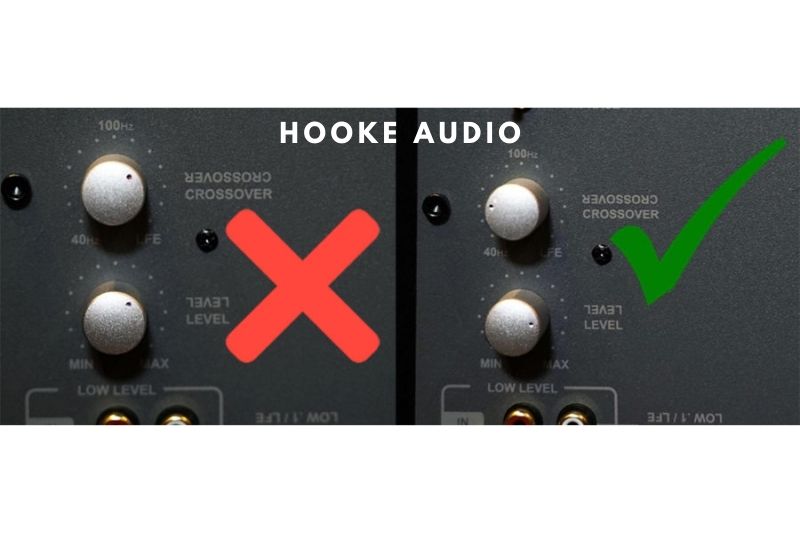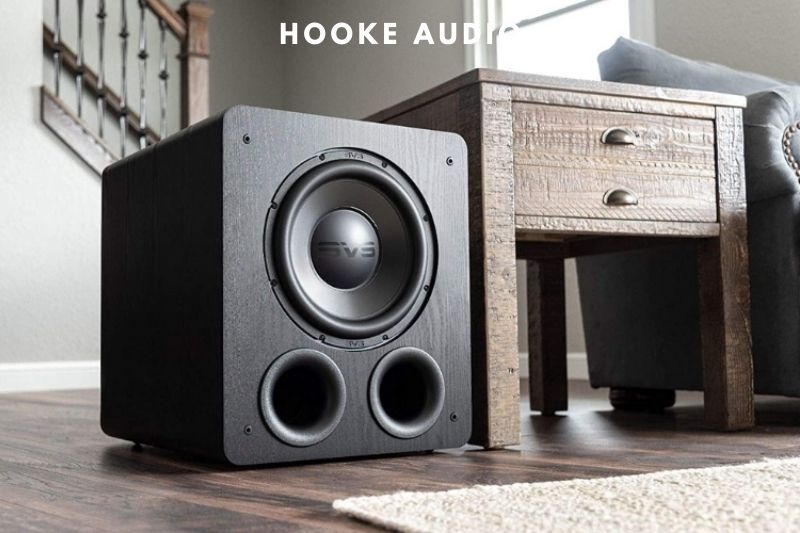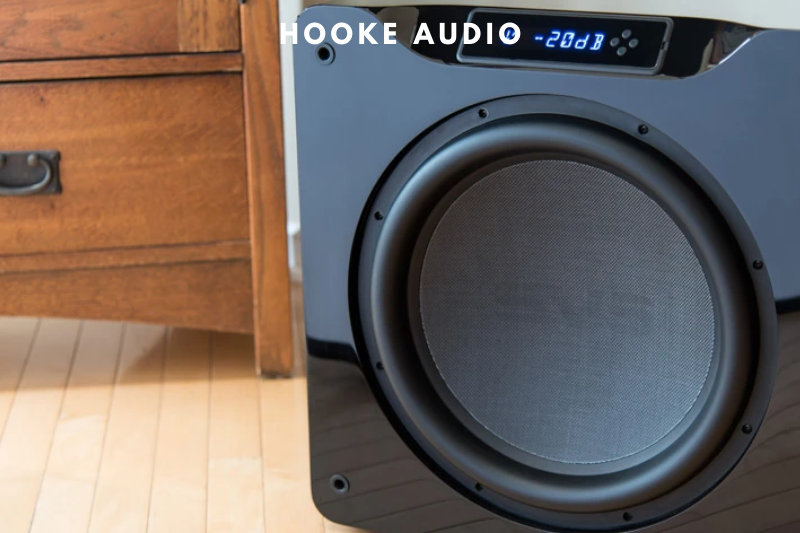How To Set Crossover For Subwoofer
The crossover is a setting that allows you to decide at what frequency range the subwoofer will be set to reproduce the bass frequencies. In this post, Hooke Audio will give you an overview of how to ready subwoofer crossover based on your arrangement's other settings and bass preferences.
Contents
- 1 Subwoofers Are Essential For Your Sound System
- 2 What is a Subwoofer Crossover and How Does It Work?
- ii.i What is a Crossover Frequency?
- ii.ii What is a Frequency?
- 2.3 What Is A Proficient Crossover Frequency?
- 2.4 Types Of Crossover Frequencies For In-Machine Audio
- three A Crucial Particular To Remember
- iv How to Set the Phase
- v How To Set up Subwoofer Crossover
- 6 How Should the Sound System Exist Configured?
- seven How to Examination the Subwoofer Crossover
- 8 How to Position Your Subwoofer Correctly.
Subwoofers Are Essential For Your Sound System
No thing what your setup is, a subwoofer is essential. A subwoofer can requite life and energy to your sound organization that is impossible with even the best speakers.
Some speakers pride themselves on their advanced bass management. No speaker, even those with a subwoofer built-in, can provide the same range as a dedicated sub. A subwoofer is essential if you want to elevate your moving picture-watching or music-listening experience.
Some may argue that speakers tin can produce the powerful bass and heart-pounding furnishings they desire for their media room.
They don't want the hassle of configuring subwoofers. Truthful to a sure extent. But if you're going to hear the high-definition audio'south actual depth, a subwoofer with the correct crossover frequency setting is essential.
What is a Subwoofer Crossover and How Does Information technology Work?
Let'southward offset define some terms we volition use in this article. These are the essentials y'all should know about subwoofer crossover settings.
- LFE, or Low-Frequency Effect, is the component of your sound organisation that creates deep sounds while listening to music and eye-pounding effects in surround sound systems.
- LFE+Main is a cross-mode that can exist establish in audio systems. It sends deep sounds to the speakers and subwoofers at a lower level than the crossover bespeak. Yous can configure it, but information technology is not always stable then it would be best to leave it as default.
- Low Pass Crossover refers to the frequency at which your subwoofers first working to reach deep notes that are not possible with the speakers we have. A low-laissez passer crossover can exist anywhere from 40Hz to 60Hz, or up to 100Hz.
- High Pass Crossover refers to the frequency above which your speakers volition piece of work and take over from the subwoofer. A subwoofer with a high-pass crossover will be repaired and will not change no thing what your setup is.
- Large speakers can produce full-range audio. This type of speaker tin produce sounds as low 20Hz if it is part of your system. A dedicated sub is required because no other speaker can attain that level.
These are the small speakers that create a crossover. It can produce sounds at frequencies that are lower than your main speakers, merely higher than your subwoofer. It is responsible for the transition between your system and the crossover.
What is a Crossover Frequency?
A crossover, in its simplest course, is the frequency at which sound transitions between one sound source and some other, usually a speaker. The electronic crossover components in passive speakers command the sound transitions between the speaker channels and a subwoofer.
Crossover Frequency is the frequency at which your speakers begin to roll off and your subwoofer kicks into action with LFEs or bass notes.
A processor sets a crossover frequency for each speaker of your car sound system. The processor redirects low-frequency audio from the speaker channels to the subwoofer channel. Digital bass management is the process that creates a seamless blend between the speaker channels and the subwoofer.
The AV processor sets crossover frequencies for each channel during auto-scale in many cases. If farther optimization is required, however, the crossover frequency may too be manually set up.
What is a Frequency?
Frequency is a term used in physics to describe the number of waves passing a point at a given time. It is as well divers as the number of cycles of vibrations that a torso experiences in a unit of time when information technology is in periodic motion.
You can define a "fixed place" as whatever location that includes your headphones, speakers, or amplifiers. Frequency response is a mensurate of how well an audio producer reproduces all the tones that nosotros hear.
Frequency is measured using the hertz (Hz), unit. The hearing range for humans is xx Hz to xx kHz. The frequency response can be divided into three principal segments: bass, centre-frequency, and treble.
What Is A Skillful Crossover Frequency?
A good crossover frequency is a frequency at which the crossover can effectively filter out unwanted sounds. Because of the many factors involved in setting a crossover frequency, it can exist difficult to find a single frequency that works for all speakers. There are a few frequency ranges that piece of work in about cases.
Types Of Crossover Frequencies For In-Automobile Audio
At that place are three types:
- Active crossovers are made of solid-state components. They can exist bought separately or integrated into amplifiers. They must be powered in order to function.
- Passive crossovers practise not require power to operate as active crossovers. They are placed betwixt the amps and the speakers where they filter out unwanted frequencies. Built-in speakers are often passive crossovers.
- Digital (software-based) crossovers are used in digital music. This type of crossover can exist establish in the software code for the car stereo head unit.
At that place is no perfect crossover frequency that will work for all speakers in every motorcar. Crossovers in nearly all cases will need some sort of adjustment to maximize their effectiveness.
A Crucial Particular To Call up
You demand to place the speaker type before you tin can set the crossover frequency. Once you know what type of speaker you take, it is possible to work out the recommended crossover frequency. Subwoofers are an instance. The recommended crossover frequency for subwoofers is eighty Hz.
ane. Once you have a skillful idea of your speaker's frequency range fix the crossover betoken approximately 10 Hz higher than the lowest frequency to ensure your speakers are able to handle it cleanly.
ii. 80 Hz is the almost common frequency for crossovers (and it's also the THX standard).
3. These numbers are intended to provide guidelines for crossover frequencies betwixt speaker/subwoofer speakers:
- On-wall or Tiny 'satellite' speakers: 150-200 Hz.
- Small center, environment, bookshelf: 100-120 Hz
- Mid-size center, surround, bookshelf: 80-100 Hz
- Large middle, environs, and bookshelf: 60-80 Hz
- Extensive middle, surround bookshelf: 40-60 Hz.
- Belfry speakers with 4″-6″ woofers: sixty Hz.
- Tower speakers with eight″-10″ woofers: 40 Hz or Large/Full-Band (i.e., full-range).
four. Look for a shine transition from speakers to subwoofer. The platonic blend will be seamless and y'all won't even exist able to pinpoint the bass. Everything will piece of work in harmony.
5. You might notice a bass bump near the crossover frequency. Adjust the volume control to match your primary speakers' output.
How to Set the Phase
Offset, you must position your speakers in the correct direction. This will allow you to better assess the sound quality. Subwoofers may not be in phase with i another. This tin can cause subwoofers to cancel each other's bass, which will issue in poor quality sound overall.
You lot can't change the wires if you take RCA cords attached to your speakers. A phase switch is the best pick in this case. This is done by setting up your speakers in a manner that allows you to still hear them, even if they are not fully installed in the amusement box or wall. Later yous have done this, take a look at the audio quality. You can adapt the stage to 0 or 180 if the bass is not satisfying yous.
How To Set Subwoofer Crossover

You lot are lucky if a mod AV receivers feature an auto-EQ program in your motorcar. This program assigns the crossover frequency to vehicles automatically. It'due south best to leave the settings as they are considering they are tailored to your automobile audio system.
Setting a crossover frequency for vehicles that don't have an AV receiver takes some patience and time. This process requires lots of listening and tweaking to get the best results.
These are the steps to set up crossover frequency:
- Find out the speakers frequency range. Play music or audio that has a dynamic frequency range (bass, mid-range, and loftier sound). You can listen to the music and decide which range sounds best. If you don't know the frequency range of your speaker, utilize a subwoofer matching tool.
- The crossover point should exist ready at 10 Hz below any speaker that can produce the lowest frequency without issues. Proceed in heed that 80 Hz is the most mutual crossover frequency recommended.
- Play some music over again. Now, turn the volume up slowly until your receiver begins to misconstrue. Once you have reached the book point where distortion begins, lower the book until the music is clear once again. Then annotation the volume of the receiver at this betoken. This is the volume threshold for your receiver.
- Set the gain on your subwoofer amp at its lowest value (a total counterclockwise position). Switch on the low-laissez passer filter and accommodate it clockwise to the maximum.
- Listen to some sound. Heed to the audio and and then expect for the subwoofer and speakers to transition smoothly. Yous should not exist able to distinguish the bass point from the speakers in an ideal situation. It should sound like everything is playing in unison.
- You may hear bass bumps when you accommodate crossover frequency. Arrange your volume command to lucifer the output of your chief speakers. Turn upwardly the receiver's volume until it reaches its maximum distortion-gratuitous level (the threshold). Slowly increase the proceeds of the subwoofer amplifier until the bass sounds are balanced with the residue of the sound spectrum.
How Should the Sound Arrangement Be Configured?
You can adjust the crossover position of your subwoofer when it is connected to an amp speaker post.
This is why many people feel overwhelmed by the procedure. You tin can see the command knobs on the dorsum of large speakers to prepare the crossover. There is no prepare formula for setting your subwoofer. You'll demand to adjust information technology to your ears.
You want the large, pocket-sized and main speakers to overlap. Yous can't only look at your sub to configure, it must have the correct amount. Too much overlap can cause a peak in the transition and too little can create depth or discontinuity in harmony. These are not the effects you want when setting up your speaker organisation to work with your sound organisation.
Yous want your subwoofer part of a well-synchronized system that creates harmony. If someone tells your subwoofer that it is distinctive and beautiful, yous are not using the correct setup. A well-designed subwoofer won't exist distinguished from your other audio system and shouldn't produce a audio that sounds like it's from an independent entity.
Deep bass is a nifty audio, especially when you use a full-range Subwoofer. Without the proper corporeality of overlap, you might hear a sudden drop-off in notes, which could be a sign that your amplifier is not working properly or a short but noticeable cut in your sound. The proper crossover frequency setting allows for smooth transitions from depression-pass to high-pass crossovers without noticeable interference.
How to Test the Subwoofer Crossover
Once you have set upwards the crossover's starting point, it is time to test the audio organization. It cannot be like shooting fish in a barrel to try your sub crossover. Yous must cull a familiar sound that yous can place with your brain.
It would assist if y'all reduced overlap to make it less noticeable. To accomplish the desired transition, increase your overlap slowly if there is a discernible discontinuity.
You might hear bass bumps when your sub and speakers overlap during your testing. This is not a problem with the crossover merely with the output volume.
These bumps tin can exist fixed by setting your subwoofer volume at the same level equally your main speaker output book. Because it will bear upon the polish transition y'all want to brand, both output volumes should be equal.
Yous will nearly ever need to adjust the crossover manually by your ear. There is ever an exception. In this case, you have a tool to check the crossover of your subwoofer.
A bass frequency sweep tin be used whenever you don't feel like diving into the details of setting upwardly sound systems or aren't comfortable making those adjustments on your own.
A bass frequency sweep is an musical instrument that creates a tone that begins at the highest frequency and ends at the everyman for any setup. This tool is extremely useful because you about likely already have it in your possession. These tones will be embedded in every THX-certified motion picture.
You can find the THX Optimizer application in the Extras section of the carte for any movie with the logo THX. This app will create a tone similar to a frequency sweep. It will let you to determine if you are experiencing drops, peaking, or bumps within your soundAdjust your organization's audio output accordingly system.
Suppose you hear a distinctive audio when this app appropriately. If yous take a peak or drop, reduce the overlap and increase it, or conform volume output if there is a bump.
There are occasions when your output is inconsistent despite numerous adjustments. It could be that your subwoofer position is not correct for your sound organization.
How to Position Your Subwoofer Correctly.

This communication may be familiar to you: Place your subwoofer nigh the wall or in the corner to go more than bass. It's true. But it might not exist the bass you desire. This could be the reason you are experiencing peaks and drops in your sound system's output, even if y'all have the settings you want.
When it comes to finding a spot for your subwoofer, you cannot use carte blanche. You lot can employ this simple test to determine where your subwoofer should be placed.
- Place your subwoofers in the heart of your room.
- Y'all can use whatever sound that has rich bass or is familiar to yous.
- You tin can move around the room to notice the best-sounding LFE. Proceed these points in mind.
- Continue moving until you notice the best spot for bass.
- Then, place your subwoofer at each of these places and then perform a bass frequency sweep.
Read more: Where To Put Subwoofer In Room? Top Full Guide 2022
Y'all can leave it every bit is to get the all-time results, then you tin can configure the crossover according to your test results, either low-pass or high-laissez passer.
You might notice your subwoofer at the worst possible places. You lot will need to remodel or fifty-fifty rebuild your media room if you want the perfect corporeality of overlap.
You might consider the Rule of Thirds for subwoofer placement if you lot don't want to reconfigure your media room. This means that you lot volition go improve bass output if you measure the space from the adjacent wall side by side.
Although the Rule of Thirds may not always produce the all-time bass, it does reduce the likelihood of standing waves or nulls. Y'all can besides avert the hassle of redesigning or rebuilding a media room.
To test if the corner can improve your test results, you tin also use it. We are not saying that the corner is the worst place for subwoofers.
You tin can't just put it there and wait to get the best possible bass output. To observe the perfect spot for your subwoofer, you may need to place it 6-eight inches from the corner. After each test, motility information technology slightly to ensure the best placement.
Source: https://hookeaudio.com/how-to-set-subwoofer-crossover/


0 Response to "How To Set Crossover For Subwoofer"
Post a Comment